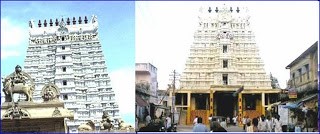Shri Vishweshwara is located where the Varana and Asi rivers meet the Ganges, a beautiful city built there in ancient times. It was called Varanasi. Varanasi, a place of pilgrimage, a tribe called kasha used to live there. Therefore, Varanasi is also known as Kashi.
Near Kashi, Ganga flows in the shape of a bow. It has therefore gained special importance. A king named Deivodas expanded this area.
The seat of Nirvikar anya and Satan Brahma has taken the form of Saguna Vishwarupa from Nirgun Roopa or first form. Shiva Roopa became Purusha (man) and Stree again.
Prakriti and Purusha (Nature and Man) were once anointed by Shiva to make Tapas in the universe for good. He described the best place for this purpose, Nirgun Shiva, with his power and the beautiful city called Panchakoshi.
Vishnu, who had been praying for Shiva for a long time after which the water was there, Vishnu was amazed at this wonderful event, and in his head, a precious stone was heard in his ear. Because of this, it is also called Manikarnika.
The entire Panch Koshi water area was then collected at his Trophy by Shiva. Here is V walking with his wife. After that from the center of Vishnu was born a lo with Brahma in it. Brahma was anointed by Shiva to create the world Brahma created this beautiful world.
There were five crore Yojanas of (The Woman) (Shiva-Shakti) who ordered to create the world. When prayer aura. created here, spent many rings from the ven as he plowed the area, it was the Manikarnika ishnu slapt tus flower, in that area and fourteen Lokas.
To save the lives of those bound by their actions or Karma, Shiva has kept the city of Panchakoshi far from the rest of the universe. In this city, Shiva himself has founded a savior Muktidayak Jyotir Linga, who will never leave. Shiva removed the very Kashi from his President and placed him in this mortal world.
It was not to be destroyed at the end of Brahma's day, but during the time of Prayay that is, the final destruction of the earth, Shiva saved it by keeping it safe in his trident. In Kashi, the Avimukteshwar Linga exists forever. For those who will never hope for salvation, find Moksha here.
This holiest city of Panchakoshi, capable of eradicating every sin imaginable, is a special Moksha vehicle named "Samyugna". That is why this city is ruled by Brahma. Vishnu and Mahesha is a place where even the gods want to die.
Sarwaguna inside and Tamoguna outside, are the qualities of Rudra here. During the prayer, Vishwanatha Bhagavan Sri Shankar did the above and sat down with Parvati. The town of Kashi is the site of Moksha and Ganga.
Those who live in him find Mukti or Sindiso, even without going to any place to visit. Anyone, be it man, woman, young, old, Sadvava, Pavitra, Apavitra, Prasuta, Aprasuta, Shadesh, Andaja, Udibhaja, Brahman, Kshatriya, Vaishya, and Sudra, all found Moksha.
There is no doubt about this. Whatever the person may be doing, eat it. sleep or anything else, if you leave this country from Avimukteshwar, you will definitely find Moksha. Any small act of beauty or of Punyakarya. takes away all sins.
Good people and bad people are born into this world. But by staying in Kashi, they both found Moksha. Later, more people came to build the temple. A king named Banar developed the city of tourism. About one and a half thousand beautiful temples are built here, the Vishweshwara temple tower is a hundred feet high.
KashiNagar is so large that even if the whole universe were destroyed in the Palace, it could remain unchanged. Dandapani and Kalabhairan guard the city. They lived there permanently. On the banks of the Ganga here there are eight bathrooms.
There are also several Teerthkundas. They have been there since the days of the Vedas. Varanasi, a devout Hindu pilgrimage, soon became a spectacle for Muslims.
From 1033 to 1669 AD Kashi was subjected to devastating attacks, temples were demolished and Masjids were built there instead. But thanks to the devotion of the devout Hindus, the JyoterLinga pilgrimage continued to flourish.
During the British and Maratha colonies, the area developed quite well. Even the monks of Jaina and Boudha helped to preserve the image of the site. The temple of Kashi Vishweshwar as we now see was built by Ahalya Devi Holkar in 1777 AD. It. In 1785 AD, the then king of Kashi, Mansaram, and his son h3lvant Singh built many other temples near Varanasi.
In 1755 AD the Avadh pant pratinidhi (representative) renovated the ancient temple of Binlumadhava and renovated the Temple of kalab hairava as built by Srimant Baji Rao Pesha in 1852 A.D. King Ranjit Singh had towers of the Kashi Vishwanath temple covered in gold.
A large bell hung in the temple. Presented by the King of Nepal. Around Saranath, there are numerous Buddhist monks, Viharas and Chaitra grihas. In 1931 AD, the Mahabodhi community built the magnificent Baddha Temple in Saranath.
Hindu devotees visit Kashi to offer sacrifices. Here they perform many rituals and feel blessed. On the other hand, several foreign tourists visit the area regularly. Pla.:es to see included, Ghats, Temples, Tapobhoomi and beautiful scenery.
Kashi Kshetra and Sri Vlshweswara JyotirLinga are considered to be the most sacred places in the world. To die in Kashi or to perform the last rites is considered the way to the Heavens i.e. Moksha.
Jaya Gange, Jaya Vishwanath, Om Namah Shivaya. The whole place echoes where there are chantigs. The gods of Varanasi are described in Sanskrit as follows: "Vishweshwaram Madhavam Dhundi Dandapanimcha Bhairavam Vande Kashim Gashamganga Bhavane manirookarnikaam.







